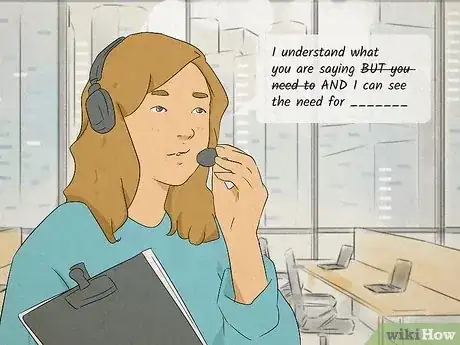This article was co-authored by Trudi Griffin, LPC, MS. Trudi Griffin is a Licensed Professional Counselor in Wisconsin specializing in Addictions and Mental Health. She provides therapy to people who struggle with addictions, mental health, and trauma in community health settings and private practice. She received her MS in Clinical Mental Health Counseling from Marquette University in 2011.
There are 19 references cited in this article, which can be found at the bottom of the page.
wikiHow marks an article as reader-approved once it receives enough positive feedback. This article has 19 testimonials from our readers, earning it our reader-approved status.
This article has been viewed 868,518 times.
Handling people who are angry at you can be difficult. Anger can erupt in almost any situation: with a friend, a stranger, at home, or in traffic. Angry confrontations can also occur at work, with coworkers, supervisors, or customers. This is especially likely if your job involves direct contact with the public, such as providing services or handling money.[1] The experience may be common, but it’s still unpleasant and confusing. You can’t control how the other person reacts, but there are some strategies you can use to keep yourself safe and control your side of the interaction.
Steps
Securing Your Safety
-
1Remove yourself from a situation that feels dangerous. You may not always have the option to outright leave an angry situation, such as a customer shouting at you while you’re working. However, if you sense that you are in danger, leave the situation, or try to get as much distance between you and the threat as possible.
- If you are dealing with an angry person in your home or workspace, go to a safe, preferably public, place. Avoid places without exits, such as bathrooms. Avoid places that have items that could be used as weapons, such as kitchens.
- If you are dealing with an angry customer at your job, try to keep physical distance between you and the customer. Stay behind your counter or stay out of arm’s reach.
-
2Call for help. You have the right to remain safe. Depending on the type and severity of the threat, you can call a friend for help. If you feel as though you are in imminent danger, call 911 or emergency services.
- At work, call for a person of authority, such as a manager or security guard.
Advertisement -
3Take a “time out.” If the situation is tense but not actively dangerous, ask for a time out. Use an “I”-statement, such as “I need to take 15 minutes to cool down before we talk.” During this period, do something calming to get a handle on your own emotions and give the other person time to cool down. Meet back at a specified place and time to discuss the issue.
- Always use “I”-statements when calling for a time-out, even if you believe the other person is entirely to blame for the situation. Saying “I need a little time to think” may disarm the angry person, rather than putting him or her on the defensive.
- Avoid accusative statements, such as “You need to take a time-out” or “Chill out.” Even if you feel these are true, they will put the other person’s defenses up and could make him or her even angrier.
- Don’t be afraid to call for another time-out if the other person is still hostile or angry. Ideally, both of you will do something to calm and soothe you during the time-out.
- If a few time-outs have still not allowed the other person to calm down, consider suggesting that you wait to discuss the issue until you can have a neutral third party present. This could be a therapist, HR representative, spiritual figure, etc.
Monitoring Your Responses
-
1Take a deep breath. Stressful situations, such as when someone is angry with us, can provoke a “fight-or-flight” response that speeds up our heart rate, makes your breathing rapid and shallow, and sends stress hormones surging through your body.[2] Counteract this response with deep breathing to help you remain calm. Remember: two angry people make a tense situation twice as bad.[3]
- Inhale for a count of 4. You should feel your lungs and abdomen expand as you inhale.[4]
- Hold for 2 seconds, then slowly release your breath for a count of 4.
- As you exhale, focus on relaxing the muscles in your face, neck, and shoulders.
-
2Monitor your emotions. Reacting calmly to the angry person will help defuse a tense situation. Responding with anger of your own will only escalate the situation and will usually make things worse. Going for a walk, meditating, and counting backwards from 50 are all ways you can calm yourself down.[5]
-
3Avoid taking it personally. It can be very difficult to disengage personal feelings from a confrontation with an angry person. Remember that anger is often a sign that the other person has not learned to respond in a healthy, assertive way to situations s/he experiences as threatening.[6] Studies have shown that when people remind themselves that they are not responsible for another person’s anger, they are less likely to feel upset by it.[7]
- Anger escalates because of several factors: insecurity, lack of choices, disrespectful behavior, or aggressive or passive responses to a problem.
- People feel insecure when there is a degree of unpredictability in a situation. When a basic degree of order and security are threatened, people may react in anger.
- People may respond with hostility when they feel choices are limited. This stems from a sense of powerlessness from having little to no options in a situation.
- When people feel they are being disrespected, they may react in anger. For example, if you speak to someone in an angry tone or are not respectful of someone's time, s/he may become angry with you.
- People may become angry to make themselves feel better. If someone is angry, consider the possibility that it’s a response to something about his or her own life, not anything you’ve done.[8]
- If you have wronged the other person, take responsibility for your action and apologize. You are never responsible for the other person’s response; nobody “makes” someone else angry. However, owning up to your own wrong action may help the other person process his or her feelings of anger and hurt.
-
4Remain calm. Speak in a calm tone of voice. Do not raise your voice or yell in response to the angry person. Use calm but assertive body language.[9]
- Try to avoid slouching or crossing your arms. These communicate that you are bored or closed off from communication.
- Keep your body relaxed. Be assertive: plant your feet firmly on the floor, and stand with your shoulders back and chest out. Make eye contact with the other person. This body language shows that you are calm and in control of yourself, but you are not a pushover.[10]
- Watch for aggressive responses, such as clenching your fist or jaw. Violating the other person’s “personal space” (usually a 3-foot distance) is also a sign that you may be becoming too aggressive.[11]
- Stand at an angle from the person who is angry, rather than directly across from him or her. This position may feel less confrontational.
-
5Watch out for disintegrating communication. It can be very hard to keep your cool when someone is angry at you, but it’s important to maintain calm, level-headed communication. If you notice any of the following creeping into your interaction, your communication is lapsing and you need to address it immediately:
- Shouting
- Threatening
- Name-calling
- Using dramatic or hyperbolic statements
- Hostile questions
Interacting With an Angry Person
-
1Know when it's not a good time to talk. Some emotional and physical cues are prime indicators of when disintegrating communication will take place. These are described by the acronym H.A.L.T. It stands for hungry, angry, lonely, tired. These conditions can exacerbate an already heated situation, and prevent resolution. Of course, this person is already angry with you. However, if the other person's anger does not diminish (even after a time-out), or if it is coupled with one of the other conditions, it is best to put off the discussion until everyone's physical and emotional needs are met. Briefly, we will discuss why each of these conditions hinder progressive problem-solving and communication.
- When you are experiencing physical hunger, purposeful, rational thinking goes out the window. Your body is low on fuel and you may say or do just about anything to refill the tank. Research shows that humans and animals that are hungry take more risks. Hunger affects our decision-making skills and behaviors - two things you definitely don't want to be out of your control during a confrontation.[12]
- Anger is an emotion that few people have learned to display constructively. Typically, anger is displayed with insults, name-calling, ridicule, and even physical violence. What's more, people often exhibit anger, when, in fact, they are feeling hurt, confused, jealous, or rejected. When underlying emotions are playing into the anger, a person is less likely to view the situation objectively and strive for resolution. It is best to give this individual time and space to reel in his feelings before any productive communication can occur.
- Loneliness means that a person feels isolated from others. A person who does not glean a sense of community will have difficulty maintaining objectivity during a confrontation.
- Feeling tired during an argument can be a recipe for disaster. Sleep deprivation brings with it a poor mood, poor cognitive functioning, and poor performance. Being tired also affects your decision-making abilities. You might be able to clearly see a solution if you were well-rested, but sleepiness can have your argument circling it's tail for hours with no end in sight.[13]
-
2Acknowledge the other person’s anger. When someone is screaming at you, the last thing you may want to do is acknowledge his or her anger. However, anger is often a response to feeling misunderstood or ignored. Acknowledging that the other person is angry isn’t the same as saying s/he is behaving appropriately.[14]
- Try saying something like, “I understand you are feeling angry. I want to understand what is happening. What is it that you’re feeling angry about?” This shows that you are trying to see things from the other person’s perspective, which may help him or her feel better.
- Try to avoid sounding judgmental when you do this. Don’t ask something like “Why are you being such an angry jerk?”
- Ask for specifics. Calmly ask for the specific thing that the other person is responding to. For example, “What did you hear me say that has upset you?” This may encourage the other person to slow down and think about why s/he's angry -- and s/he may realize it was all a misunderstanding.
-
3Refrain from shutting the other person down. “Shushing” or otherwise stopping the person from expressing his or her feelings will not help the situation. It may increase the other person’s feelings of anger.[15]
- Shutting the other person down communicates that you do not view his or her feelings as legitimate. Remember that even if you don’t understand the other person’s experience, it’s very real to that person. Dismissing that will not help you defuse the situation.[16]
-
4Listen to the other person. Be an active listener. Show that you are engaged with the other person by making eye contact, nodding, and using phrases such as “uh huh” or “mmm-hmm.”[17] [18]
- Don’t get caught up in preparing your defense while the other person is speaking. Focus on what s/he is saying.
- Listen for reasons given for why the other person is angry. Try to imagine the situation from his or her point of view. If you experienced this situation, would you feel the same way?
-
5Confirm what the other person has said. One reason tense situations escalate is because of miscommunication. Once the other person has told you why s/he is angry, confirm what you heard.[19]
- Use “I”-focused statements. For example, “I heard you say you were angry because this is the third cellphone you have bought from us and it isn’t working. Is that correct?”
- Saying things like “It sounds like you are saying ______” or “Is _________ what you mean?” will help you make sure you understand the other person. It may also help the other person feel acknowledged, which can help soothe angry feelings.
- Don’t embellish or reword the other person’s statements when you confirm them. For example, if the other person has complained that you have been late to pick him up the last 6 days, don’t say something like, “I heard you say that you’re pissed off because I’m always late.” Instead, focus on what he actually said: “I heard you say that you’re angry because I have been late for the past 6 days.”
-
6Use “I”-statements to communicate your own needs. If the other person is continuing to shout or be aggressive with you, use “I”-focused statements to communicate your needs. This will avoid sounding as though you are blaming the other person.
- For example, if the other person is shouting at you, you could say something like this: “I want to help you, but I cannot understand what you’re saying when you speak so loudly. Could you repeat what you said in a softer voice?”
-
7Empathize with the other person. Try to consider the other person’s side of the situation.[20] Doing so can help you keep a handle on your own emotional responses. It can also help you communicate effectively with the other person.[21]
- Saying something such as “That sounds very frustrating” or “I can see why that would be upsetting” can help defuse anger. In some cases, people just want to have their feelings of frustration validated. Once they feel understood, they may calm down.
- You may have to mentally tell yourself that the person is upset and is doing her best to communicate her feelings. This can help you to reframe the situation in your own mind.
- Don’t make light of the problem. Even if it seems trivial to you, the other person clearly feels strongly about it.[22]
-
8Avoid mentioning your intentions. Think about consequences instead. If someone is mad at you, this person feels wronged by you in some way. Your first reaction might be to defend yourself and state your intentions. For example, refrain from saying "I meant to pick up your suit from the cleaners, I just forgot because I left work late." While your intentions may have been good, at this point, the other person does not care. The person is dealing with the consequences of your actions, and that's why he/she is upset.[23]
- Rather than declaring your good intentions, try to step into the other person's shoes and notice how the consequences of your actions have affected this person. Make remarks like, "I see now that my forgetting your suit has put you in a bind for your meeting tomorrow."
- This concept may feel like you are being disloyal to your own beliefs. You may honestly feel like you did the right thing and have trouble coming to terms with being wrong. If this is the case, try to imagine that the person is not mad at you, but someone/something else. Consider how you would resolve the situation if you weren't the 'wrongdoer'.
Resolving the Anger
-
1Approach the situation with an open mind. Once you have listened to the other person, consider how you can address the situation.
- If you believe the other person has a valid grievance with you, accept it. Admit your own wrongdoing and ask what you can do to make amends.[24]
- Don’t make excuses or be defensive. This will often make the other person even angrier, because s/he will feel as though you are dismissing his or her needs.[25]
-
2Offer a solution. Be reasonable, and communicate calmly and clearly. Try to keep your solution focused on what the other person communicated to you.[26]
- For example, if the other person is angry because your child threw a ball through the window, state what you are willing to do. For example: “My daughter threw a ball through your window and broke it. I can have a repairman come out and replace it in two days. Or, you can have your handyman replace it and send me the bill.”
-
3Ask for alternative options. If the other person is not happy with the solution you suggest, ask him or her to suggest a resolution s/he would be happy with.[27] For example, you could ask something like "What would you like to see happen in this situation?"
- Try to present this as a “we”-focused solution to encourage collaboration. For example, “Okay, if my suggestion isn’t acceptable, I’d still like to see if we can find a way to address this problem. What can we do to address this situation?”
- If the other person suggests something you find unreasonable, don’t start calling names. Instead, present a counter offer. For example: "I heard you say that you want me to fix the broken window and pay for carpet cleaning for your entire house. I think it would be fair for me to replace the broken window and pay to have the living room carpet cleaned. How does that sound?"
- Trying to find common ground between you and the angry person can help redirect the interaction towards a solution. For example, you could say something such as "I understand that fairness is important to you. It is to me as well…" This can help communicate that you are working toward the same goal.
-
4Avoid using “but.” “But” is known as a “verbal eraser,” because it can completely negate what you said before it. When people hear “but,” they tend to stop listening. All they hear is ”You’re wrong.”[28]
- For example, don't say things like "I understand what you are saying BUT you need to ________"
- Instead, use "and" statements such as "I can see your point AND I can see the need for _______".
-
5Thank the other person. If you have been able to come to a resolution, wrap up your interaction with a word of thanks for the other person. This shows your respect for the other person and can help him or her feel as though his/her needs have been met.[29]
- For example, if you have been able to negotiate with an angry customer, you could say: “Thank you for allowing us to make this problem right.”
-
6Give it some time. In some cases, the person’s anger may not disappear immediately, even if you have done all you can to resolve the situation. This is especially true in situations that carry deeper hurt, such as the other person feeling betrayed or manipulated in some way. Accept that it may take some time for angry feelings to resolve themselves, and don’t push.
-
7Find a third-party mediator, if necessary. Not all conflicts can be resolved, and not everyone’s anger will dissipate even if you stay cool and respectful all day long. If you have tried the tactics here and have made no progress, it may be time to step away. A third party, such as a therapist, mediator, or HR representative, may be able to help you negotiate the situation.
-
8Consider getting professional help. Beyond accessing the services of a mediator, seeing a therapist or psychologist who is trained in conflict resolution or anger management may be helpful. This is especially so if the person who is angry with you is a significant person in your life, such as a spouse, parent, sibling, or child. If the two of you are constantly arguing, or if one person tends to fly off the handle at the slightest provocation, you may need to see a professional who can not only mediate the situation, but also teach you effective problem-solving and communication skills.
- A therapist can teach your family member or friend ways to relax and handle stress, methods of overcoming angry feelings, strategies of expressing emotions, and ways to recognize negative thought patterns that cause anger.[30]
Apologizing Effectively
-
1Think about what you did to anger the other party. If you did something wrong, you may need to remedy the situation by apologizing and making amends.
- Don't try to make excuses for your behavior. If you did something to wrong the other party, you need to acknowledge your mistake.
- Think about whether or not an apology is best during the interaction or later after s/he has calmed down.
- Assess whether or not an apology would be heartfelt and meaningful to the situation. You should not apologize if you don't mean it, as this might escalate the problem further.
-
2Express empathy and regret. You need to show the person that you have remorse for how your words or actions affected him or her.
- You may not have intended to make this person angry or hurt his or her feelings. Regardless of your intentions, you need to recognize that your behavior had a negative effect on the other person.
- Frame your apology first around a statement of remorse. For example, you could start by saying "I am so sorry. I know I hurt your feelings."
-
3Accept responsibility for your actions. Your apology needs to include a statement about responsibility to be effective and diffuse the situation. In other words, you need to state how your actions contributed to the other person’s feelings of hurt or frustration.
- A statement of responsibility may sound like "I am sorry. I realize that my being late made us miss the event"
- Alternatively you could say "I am sorry. I know my carelessness caused you to fall"
-
4Offer a remedy to the situation. An apology is meaningless unless you state how the situation can be fixed or avoided in the future.
- An offer to remedy the situation can include an offer to help the other person or a means by which you not repeat the same mistake again in the future.
- For example, you could say "I am sorry. I know my being late caused us to miss the event. From now on I will set an alarm on my phone an hour before I need to be ready".
- Another example would be "I am sorry, I know my carelessness caused you to fall. I will pay better attention to where I put my belongings in the future."
Warnings
- Be wary of people who say things like “Why do you always make me so angry?” This is a sign that they are not accepting responsibility for their actions.⧼thumbs_response⧽
- Do not resort to violent language or behavior of your own.⧼thumbs_response⧽
- Avoid mouthing off to them.⧼thumbs_response⧽
- If you feel like you are in danger, call for help and try to leave the situation.⧼thumbs_response⧽
- Sometimes, things like this might end in a fight. Be careful.⧼thumbs_response⧽
References
- ↑ https://www.osha.gov/OshDoc/data_General_Facts/factsheet-workplace-violence.pdf
- ↑ http://www.angermanagementresource.com/angry-people.html
- ↑ http://psychcentral.com/blog/archives/2012/07/26/how-to-switch-off-an-angry-person/
- ↑ http://www.health.harvard.edu/mind-and-mood/relaxation-techniques-breath-control-helps-quell-errant-stress-response
- ↑ http://academicaffairs.ucsd.edu/_files/ug-ed/uaac/Dealing_with_an_Angry_Individual.pdf
- ↑ http://psychcentral.com/blog/archives/2012/07/26/how-to-switch-off-an-angry-person/
- ↑ https://journals.sagepub.com/doi/abs/10.1177/0956797612438559
- ↑ http://psycnet.apa.org/journals/psp/81/1/17/
- ↑ http://www.bodylanguageexpert.co.uk/bodylanguagetodealwithdifficultpeople.html
- ↑ http://changingminds.org/techniques/body/assertive_body.htm
- ↑ http://www.cci.health.wa.gov.au/docs/Assertmodule%202.pdf
- ↑ http://bigthink.com/risk-reason-and-reality/the-risks-of-hunger-it-makes-you-take-more-risks
- ↑ http://greatergood.berkeley.edu/article/item/sleep_before_you_bicker
- ↑ http://academicaffairs.ucsd.edu/_files/ug-ed/uaac/Dealing_with_an_Angry_Individual.pdf
- ↑ http://academicaffairs.ucsd.edu/_files/ug-ed/uaac/Dealing_with_an_Angry_Individual.pdf
- ↑ http://www.mindtools.com/pages/article/dealing-with-angry-people.htm
- ↑ http://www.angermanagementresource.com/angry-people.html
- ↑ http://www.mindtools.com/CommSkll/ActiveListening.htm
- ↑ http://www.mindtools.com/CommSkll/ActiveListening.htm
- ↑ https://bottomlineinc.com/health/mental-health/how-to-handle-someone-elses-rage
- ↑ http://www.mindtools.com/pages/article/dealing-with-angry-people.htm
- ↑ https://bottomlineinc.com/health/mental-health/how-to-handle-someone-elses-rage
- ↑ https://www.psychologytoday.com/blog/how-we-work/201304/what-do-when-you-ve-made-someone-angry
- ↑ http://www.mindtools.com/CommSkll/ActiveListening.htm
- ↑ http://www.mindtools.com/pages/article/dealing-with-angry-people.htm
- ↑ https://bottomlineinc.com/health/mental-health/how-to-handle-someone-elses-rage
- ↑ https://bottomlineinc.com/health/mental-health/how-to-handle-someone-elses-rage
- ↑ http://strategicdiscipline.positioningsystems.com/blog-0/bid/82716/Verbal-Eraser-Destroys-Positive-Reinforcement
- ↑ https://bottomlineinc.com/health/mental-health/how-to-handle-someone-elses-rage
- ↑ http://www.apa.org/topics/anger/help.aspx
About This Article
Dealing with an angry person can be stressful, so it's important for you to take steps to stay safe and avoid escalating the situation unnecessarily. If you feel unsafe or threatened, leave the situation or put as much distance between you and the angry person as possible. You can also call a friend or colleague for help if you feel in danger. Before you say anything in response to the angry person, take a couple of deep breaths, since being the target of someone’s anger can be stressful and may provoke an uncontrolled response. Speak to them in a calm but assertive voice to try and deescalate the situation. For example, you might say, “I understand you’re feeling angry. What is it you’re feeling angry about?”. This lets the other person know you’re prepared to listen to them, which may help them control their emotions. You should also try to keep your body language relaxed while standing tall and making eye contact with the other person, which shows them you’re not intimidated by their anger. For tips from our co-author on how to apologize if someone is angry at you, keep reading!




























































































Medical Disclaimer
The content of this article is not intended to be a substitute for professional medical advice, examination, diagnosis, or treatment. You should always contact your doctor or other qualified healthcare professional before starting, changing, or stopping any kind of health treatment.
Read More...